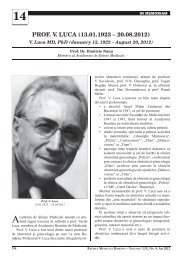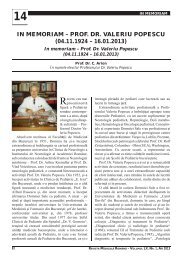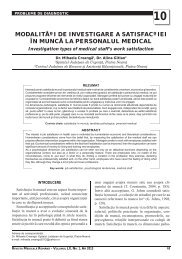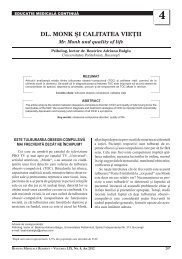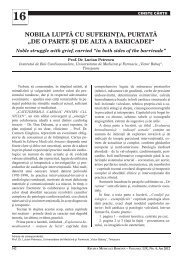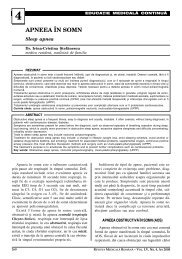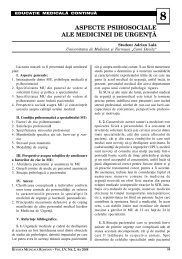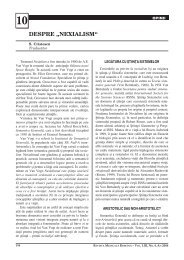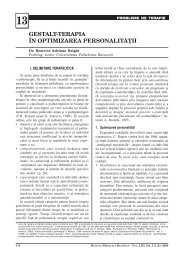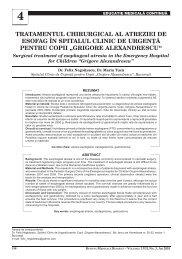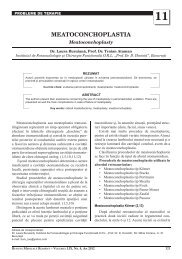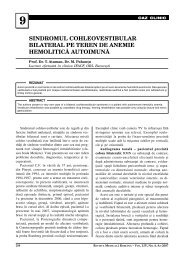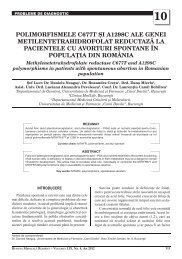You also want an ePaper? Increase the reach of your titles
YUMPU automatically turns print PDFs into web optimized ePapers that Google loves.
148<br />
ignored or neglected due to the small dimensions<br />
and slow evolution, or they are mistaken as easy<br />
lesions.<br />
We used THz spect<strong>ro</strong>scopy to differentiate between<br />
BCC and normal skin slices. Normal skin<br />
and BCC samples with a surface of ~1 cm 2 were<br />
embedded in paraffi n. THz spect<strong>ro</strong>scopy experiments<br />
were performed on 5, 10, 15 and 20 μ slices<br />
mounted on 0.13-0.17 mm thick glass slides. In order<br />
to establish the correlation between THz absorption<br />
and tissue structure, we also performed a<br />
histopathological analysis of the samples. Our results<br />
show that, independent of thickness, the BCC<br />
slides have an increased THz absorption in comparison<br />
to the normal skin slides. The normal skin<br />
dermis presents a higher THz absorption than the<br />
normal skin hypodermis slides. Also, the solid BCC<br />
samples present a higher THz absorption than BCC<br />
samples with cystic aspects. The differences of absorption<br />
between solid and cystic BCC samples are<br />
a consequence of the differences in cell density.<br />
Interacti ons of normal and mutant human<br />
TPH2 with substrates and inhibitors by<br />
molecular docking<br />
Octavian Calborean, Maria Mernea,<br />
Dan Florin Mihailescu<br />
University of Bucharest, Faculty of Biology, Department<br />
of Anatomy, Animal Physiology and Biophysics<br />
Tryptophan hyd<strong>ro</strong>xylase (TPH) catalyzes the<br />
hyd<strong>ro</strong>xylation of L-tryptophan into 5-hyd<strong>ro</strong>xytryptophan.<br />
This is the fi rst and rate-limiting step in<br />
the se<strong>ro</strong>tonin synthesis pathway. There are two human<br />
isoforms of TPH: TPH1, primarily expressed<br />
in the ente<strong>ro</strong>ch<strong>ro</strong>maffi n cells of the gast<strong>ro</strong>intestinal<br />
tract, and TPH2, expressed exclusively in neu<strong>ro</strong>nal<br />
cells. The active form for both enzymes is the tetrameric<br />
one. Single nucleotide polymorphisms of<br />
TPH2 gene (P<strong>ro</strong>206Ser and Arg441His) are associated<br />
with depression and bipolar disorder, as well<br />
as sleep disorders and substance abuse. The 3D<br />
structure of human TPH2 has not been experimentally<br />
determined yet. Our objective was to investigate<br />
the TPH2 binding physiology at the molecular<br />
level and to explain the impact of mutations on<br />
TPH2 interaction with substrates and the interaction<br />
with inhibitors using molecular dynamics and<br />
docking techniques. We used homology modeling<br />
to build structural models of the tetramers of wild<br />
type and mutant (P<strong>ro</strong>206Ser and Arg441His) TPH2<br />
with Fe 3+ bound to 3 water molecules in the active<br />
REVISTA MEDICALÅ ROMÂNÅ – VOLUMUL LIX, NR. 2, An 2012<br />
catalytic site. We used as templates the known crystal<br />
structures of several related enzymes: human<br />
TPH1 with Fe 3+ bound to 3 water molecules and<br />
dihyd<strong>ro</strong>biopterine; rat and human phenylalanine<br />
hyd<strong>ro</strong>xylases. We then refi ned the three models by<br />
more than 10 nanoseconds of molecular dynamics<br />
in aqueous solutions. We then docked the minimized<br />
structures of tryptophan, tetrahyd<strong>ro</strong>biopterin<br />
(BH4), and two known inhibitors of human TPH1<br />
(LP-533401 si LP-615819) to the TPH2 models.<br />
For each docking of substrate of inhibitor, we extracted<br />
10 binding positions for which we calculated<br />
the interaction energies. Out of the 10 positions<br />
we chose the one most favourable sterically and we<br />
analyzed the details of its binding. The two mutant<br />
models bind tryptophan and BH4 st<strong>ro</strong>nger than the<br />
wild type, in accord with the experimentally determined<br />
Michaelis constants. In the case of the two<br />
inhibitors, we observed that LP-615819 binding to<br />
TPH2 is less favourable energetically and sterically<br />
then LP-533401. This result is in good correlation<br />
with the experimentally determined binding constant<br />
of LP-615819 to TPH1, that is less specifi c<br />
than that of LP-533401.<br />
Identi fi cati on of potenti al toxic eff ects of<br />
up-converti ng nanoparti cles<br />
Livia Petrescu 1 , Oti lia Cinteza 2 , Tudor Rosu 2 ,<br />
Serban Georgescu 3 , Dan Florin Mihailescu 1<br />
1 University of Bucharest, Faculty of Biology,<br />
D.A.F.A.B. Department<br />
2 University of Bucharest, Faculty of Chemistry,<br />
3 Nati onal Insti tute for Laser,<br />
Plasma and Radiati on Physics<br />
One of the most important achievements of nanotechnology<br />
is the luminescent nanoparticles used<br />
for sensitive biological detection applications (immunoassay).<br />
Different types of fl uorescent labels,<br />
such as organic fl uorescent markers, green fl uorescent<br />
p<strong>ro</strong>tein (GFP) and lanthanide chelates, have<br />
been reported. Compared to classical down conversion<br />
markers, the fl uorescence of lanthanide chelates<br />
have specifi c advantages. We can enumerate<br />
their higher photostability and st<strong>ro</strong>nger luminescence.<br />
We synthesized and characterized several categories<br />
of up-converting nanoparticles: Y 2 O 3 :<br />
Er +3 :Yb +3 , YVO 4 : Er +3 :Yb +3 , NaYF 4 : Er +3 :Yb +3 .<br />
Of these NaYF 4 : Er +3 :Yb +3 p<strong>ro</strong>ved to be the most<br />
effi cient and suitable for bio<st<strong>ro</strong>ng>medica</st<strong>ro</strong>ng>l applications.<br />
Synthesis of NaYF4:Yb:Er nanoparticles was<br />
performed using hyd<strong>ro</strong>thermal method. Method



